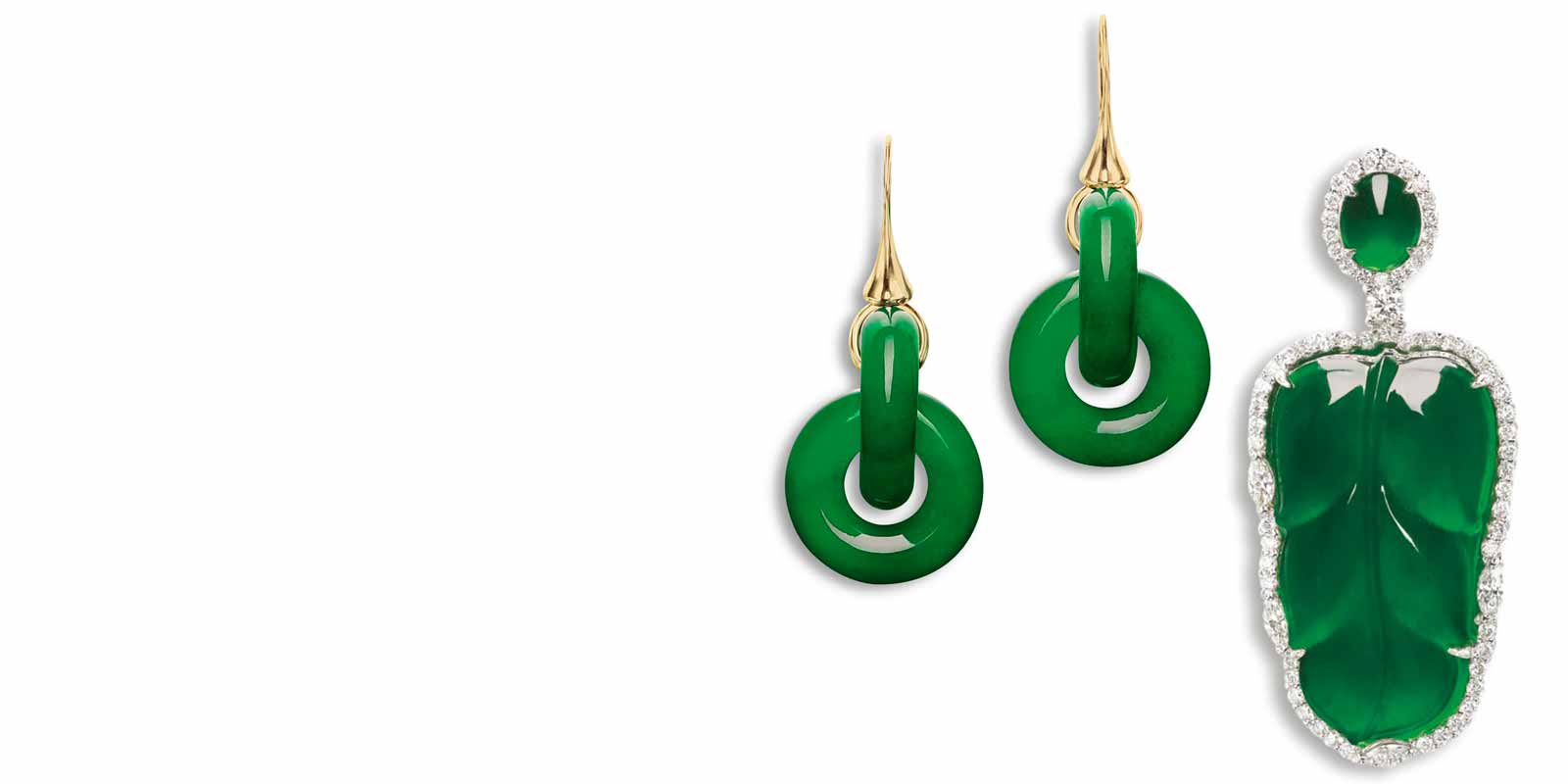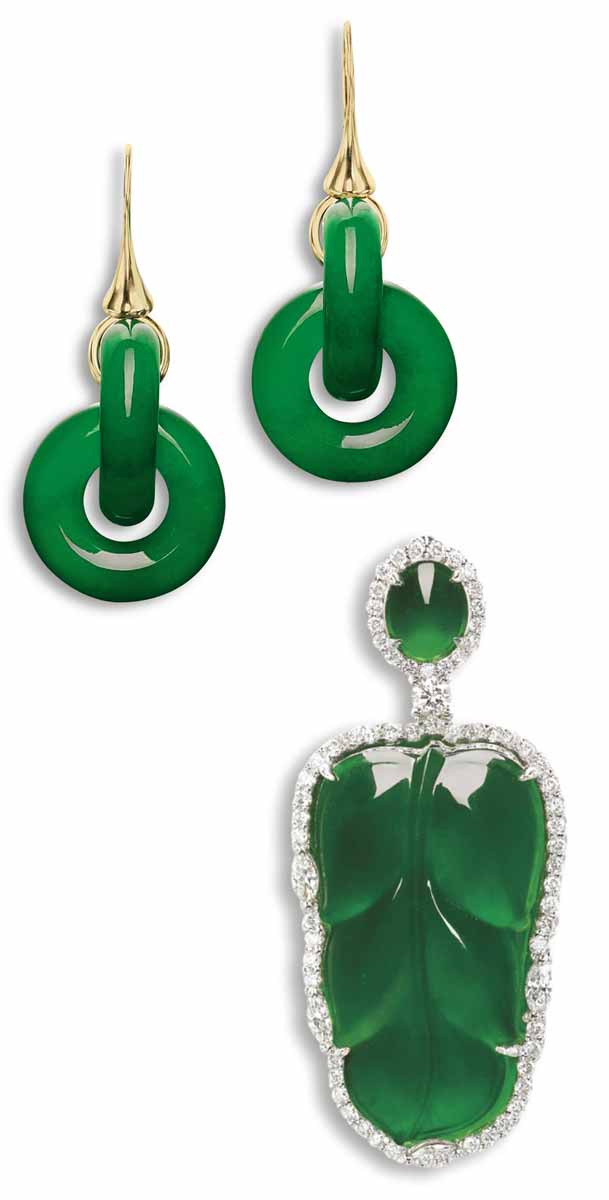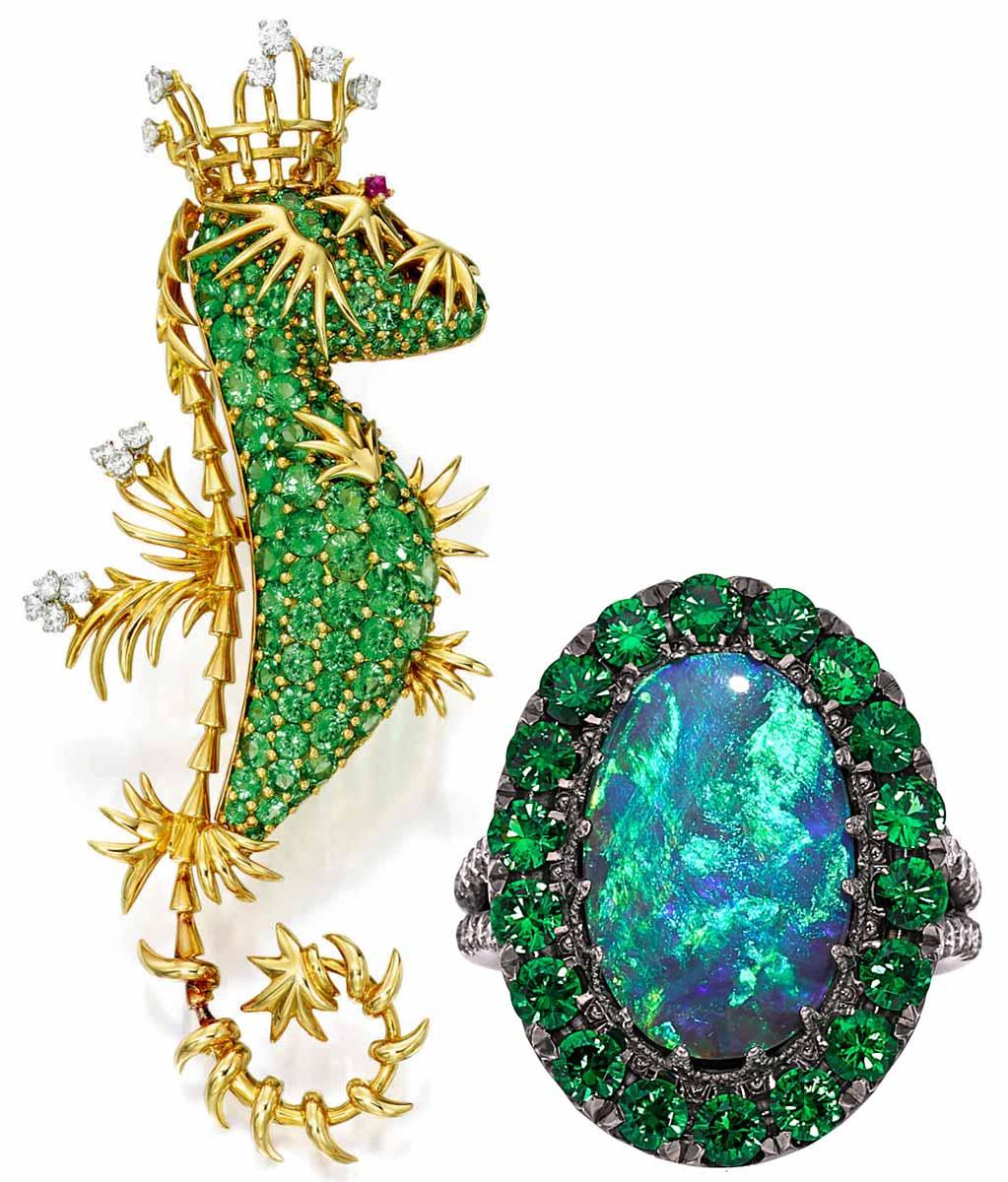
Celebrating St. Patrick’s Day, and every other day of the year, here are some green stones that delight us with the wide range of tones, cut, and degrees of transparency from absolutely clear to totally opaque and everything in between.
Look to the East
Jadeite earrings, $505,138,
Jadeite pendant, Lot #1723, $63,780
Sotheby’s Hong Kong
October 3, 2018


Look to the East
Jadeite earrings, $505,138,
Jadeite pendant, Lot #1723, $63,780
Sotheby’s Hong Kong
October 3, 2018
Compare these two fine jadeite lots from a recent sale in Hong Kong. The pair of simple double-loop jadeite earrings offers the essence of this green gemstone. Jadeite has an appeal in the Asian market, especially to Chinese customers, whose culture has a deep connection with the stone and appreciation of its subtle qualities. Jadeite, like diamonds and sapphires, occurs in a wide range of colors depending on the minerals present when it is formed. Apple green jade with the rich translucence seen here ranks highest in appreciation and consequently in price. This pair of earrings is remarkable for the intensity of the color and the translucency, clearly on display in the smoothly polished surface. There are no carvings or facets to hide any flaws. You are looking into the very heart of the mineral.
The jadeite pendant is carved in the form of a leaf, and set in a frame of diamonds. While this pendant offers a generously sized piece of jadeite, and very rich green color, the carving interferes with the ability of the viewer to peer deep within. However, the leaf is a symbol of immortality, longevity and healing, making it a potent image. Although very beautiful, and perhaps more appealing to the western eye, this piece brought a little more than a tenth the value of the double loop earrings.

Green with envy
Emerald ring, Tiffany & Co., $1,455,000
Sotheby’s New York
December 4, 2018 #79
Bulgari, $474,523
Sotheby’s Hong Kong
October 3, 2018
Depth of color and transparency are the qualities most prized in emerald, the green variety of beryl. Unlike the other gemstones commonly termed “precious,” however, emerald is rarely found without inclusions. Known by the flattering term “silk” or “jardin,” French for garden, these internal bits of alien minerals are visible to the naked eye but are still considered acceptable.
The inclusions also make emeralds more temperamental to cut, subject to breakage, affecting the strength of the stone, as well as its appearance.
This fact led to the creation of the emerald cut, with faceted corners that allow for safe placement of prongs. The right cut, created by a skilled hand at the cutting wheel, makes the most of the tone and saturation of color inherent in the emerald material.
Even dispersion of color along with a high degree of transparency set the price for a fine emerald, a price that rises into the stratosphere in the higher carat weights. Intensity of color is most desirable, as is the origin of the stone. Uniquely among gems, emeralds reveal their country of origin when viewed by a trained eye, both trade and consumer. Most highly prized are Colombian emeralds whose pure green color conveys warmth. Stones identified as coming from the African nation of Zambia are said to be cooler, with a bluish green color.
Although the differences are sometimes more in the eye of the beholder than in the material, the perception and description dictates a wide gap in pricing with Colombian emeralds fetching far higher prices per carat.
Consider the 12.03 carat emerald ring by Tiffany & Co., set with two trapeze-cut diamonds. This ring was certified by two respected laboratories to be of Colombian origin, with no clarity enhancement. If an emerald has been oiled or heated to enhance the color, these treatments reduce its value and must be disclosed by the seller. This classic emerald-cut emerald sold for $1,455,000.
Compare this single stone ring to the emerald and diamond necklace and matching earrings, by Bulgari, circa 1960. Like the jadeite pendant seen above, these emeralds were all carved into leaf shapes, effectively disguising inclusions and lack of transparency while displaying the desirable emerald color. Each of the 11 leaves on the necklace as well as the two leaves created as pendant earrings are suspended from settings of round, baguette and pear-shaped diamonds. A matching diamond necklace sets off the leaf drops.

Out of Africa
Tsavorite garnet and black opal ring, $8,750
Heritage Auctions, Chicago
June 26, 2017
Tsavorite seahorse, $20,000
Sotheby’s New York
December 4, 2018
Moving out of the “precious” category, but no less compelling, are two lots set with tsavorite garnets.
Tsavorite garnets are a relatively new gemstone find, discovered by the late geologist Campbell Bridges in East Africa in 1967. Its two mining locations, straddling the border between Tanzania and Kenya, near Tsavo National Park, suggested the name for this rare find.
Both pieces make a virtue of the mineral’s one drawback: Tsavorite generally occurs in quite small sizes. It is rare to find a well-saturated stone above a few carats.
The utterly beguiling seahorse clip-brooch by Schlumberger for Tiffany & Co., France, is set with numerous faceted round tsavorite stones in a gold frame. One ruby eye and diamonds on the spiny crown and fins complete the very lifelike little creature.
The ring combines an exquisite black opal, shimmering with oceanic shades of blue and green, centered within a frame of round tsavorite garnets. The 25 garnets weigh a total of 2.08 carats, but their small size is no drawback in complementing the dramatic opal.






















![DEl Kathryn Barton [Australian b. 1972] the more than human love , 2025 Acrylic on French linen 78 3/4 x 137 3/4 inches 200 x 350 cm Framed dimensions: 79 7/8 x 139 inches 203 x 353 cm](/sites/default/files/styles/image_5_column/public/ab15211bartonthe-more-human-lovelg.jpg?itok=wW_Qrve3)



